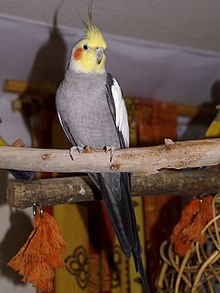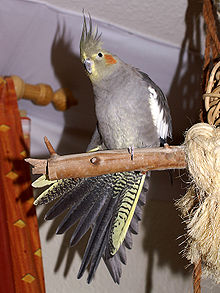Cockatiel
| Cockatiel | |
|---|---|
 |
|
| Male | |
 |
|
| Female | |
| Scientific classification | |
| Kingdom: | Animalia |
| Phylum: | Chordata |
| Class: | Aves |
| Order: | Psittaciformes |
| Family: | Cacatuidae |
| Subfamily: | Nymphicinae |
| Genus: |
Nymphicus Wagler, 1832 |
| Species: | N. hollandicus |
| Binomial name | |
|
Nymphicus hollandicus (Kerr, 1792) |
|
 |
|
| Cockatiel range (in red; all-year resident) | |
| Synonyms | |
|
Psittacus hollandicus Kerr, 1792 |
|
Psittacus hollandicus Kerr, 1792
Leptolophus hollandicus
The cockatiel (Nymphicus hollandicus), also known as the quarrion and the weiro, is a bird that is a member of the cockatoo family endemic to Australia. They are prized as household pets and companion parrots throughout the world and are relatively easy to breed. As a caged bird, cockatiels are second in popularity only to the budgerigar.
The cockatiel is the only member of the genus Nymphicus. It was previously considered a crested parrot or small cockatoo; however, more recent molecular studies have assigned it to its own subfamily, Nymphicinae. It is, therefore, now classified as the smallest of the Cacatuidae (cockatoo family). Cockatiels are native to Australia, and favour the Australian wetlands, scrublands, and bush lands.
Originally described by Scottish writer and naturalist Robert Kerr in 1793 as Psittacus hollandicus, the cockatiel (or cockateel) was moved to its own genus, Nymphicus, by Wagler in 1832. Its genus name reflects the experience of one of the earliest groups of Europeans to see the birds in their native habitat; the travellers thought the birds were so beautiful that they named them after mythical nymphs. The specific name hollandicus refers to New Holland, a historic name for Australia.
Its biological relationship had long been argued; it is now classified into a monotypic subfamily Nymphicinae but had sometimes in the past been misclassified among the Platycercinae, the broad-tailed parrots. This issue has now been settled with molecular studies. A 1984 study of protein allozymes signalled its closer relationship to cockatoos than to parrots, and Mitochondrial 12S rRNA sequence data places it amongst the Calyptorhynchinae (dark cockatoos) subfamily. The unique, parakeet (meaning long-tailed parrot) morphological feature is a consequence of the decrease in size and accompanying change of ecological niche.
...
Wikipedia

